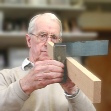

If you are involved in fine woodworking that requires a tear-free finish, it is important that the front lip of the mouth can effectively press down any fibres that might tend to lift, split ahead of the cutter and tear themselves from the body of the wood before the cutter can cleanly shear them off seeCoping With Gnarly Grain.
Note:For a good finish, a very fine shaving aperture is also essential, but that is another story.
A heavy-section, purpose-made straightedge is best, but failing this, a good quality steel rule, preferably marked British Standard 4372, is essential.
Check the edges for slight damage. Without touching the original machined edge, use a fine abrasive to remove any small nicks acquired during general use.
Rules are likely to become somewhat bowed in their thickness. This means that unless held at right-angles to the surface under test, they will give either a false concave or convex reading, depending on the inclination away from, or towards the user.
The "blade" part of a good quality combination square, which will be thicker than a normal bench rule, is less likely to have this fault. (Avoid very cheap versions, I found one to have a 0·13 mm (5 thou) error along its edge.)
If you are limited to only using a rule for testing, it is usually better to work by feel rather than try to lift and hold a heavy plane to the light. Grip the rule about its mid-point. On a convex surface it will swivel freely. The ends will tend to grip a concave surface and the middle part can be made to flex. (You might also find this advice of useful when preparing face sides, etc, on your wood).
To overcome the effects of bow, hold the face dead upright against something machined 'square' such as the side of an engineer's square or accurately planed piece of wood.
In various places along the plane use feeler gauges to check for gaps between the sole and the rule.
It would be much better, however, to use a surface plate. You can improvise one. This will be essential if the sole is to be finished byScraping Practicalities.
If you decide that your plane would justify some extra work, whether you decide to go the whole hog and scrape or not, you'll first need to abrade the sole (unless you have access to a surface grinder, of course)Grit and Determination.